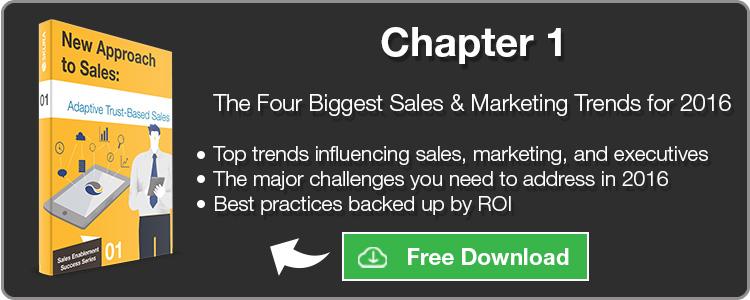Although account based marketing has shown promising returns, like any marketing program, it isn’t without its risks and drawbacks.
Understanding the challenges of account based marketing implementation enables marketing and sales to mitigate unnecessary friction and maximize ROI from the initiative.
Today’s article explores the top 5 problems with account based marketing.
Click Here to learn about the recent resurgence of account based marketing, and why it spiked in 2015.
Click Here to learn about the top 5 reasons you should be using an account based marketing strategy.
Click Here to learn when account based marketing (ABM) is an appropriate strategy for the sales process.

(Image Source: SiriusDecisions, 2015)
John Stewart, Vice President of Strategic Content at Annuitas, recently published an article where he explained four downsides to account based marketing adoption.
The risk of experiencing any one of these challenges depends largely on the tactical preparedness of the ABM team prior to implementation. Here’s a link to his full article.
We expanded upon John’s list of four, and added one of our own.
1) Only Supporting Outbound Efforts
Content marketing facilitates an inbound lead generation process – something many continue to struggle with despite strong adoption. Meanwhile, account based marketing is often referred to as outbound, and because of this, fully adopting an ABM strategy actually risks deteriorating inbound efforts.
Although both strategies appear to encompass different scopes, ABM dovetails content marketing, and an ideal strategy would be to include ABM tactics in digital content creation.
Integrating these strategies transforms traditional outbound communications from product-focused to education- and trust-focused - something sales reps already desire from their content. In this way, you’ll be further prioritizing key accounts from your previously crafted personas.
2) Alienating Non-Account-Based Buyers
Account based marketing was created to cross-sell and up-sell to existing clients, and maximize the ROI from months or years of sales process interactions.
The recent spike in ABM interest was followed by a resurgence of outbound new business creation – something that faced steady declines since inbound content marketing saturated B2B marketing communications.
The risk here is similar to retail bank promotions that reward new clients with a signing gift. New clients are thrilled by the personalized effort, but existing clients (the original focus of ABM tactics) are left out. Furthermore, if ABM lead-generation tactics are too noticeable, other potential leads left out of the target group may feel alienated.
ABM strategy needs to strike the right balance between communications that are account-based, and those that are more generic.
3) Putting Sales In Control
For those already grappling with service level agreements for sales and marketing alignment across your digital content marketing, ABM adds an additional layer of complexity.
With inbound strategy, many sales reps dislike the digital sales content created by marketing. However, the success of inbound content marketing has led to a spike in lead generation, and as a result marketing teams tend to own the inbound process even though the leads generated are typically not sales-qualified.
Where marketing teams own the inbound digital content process, account based marketing has the opposing risk.
84 percent of B2B marketers say that ABM delivers a higher ROI than any other approach (Source: Oracle, 2016). Sales reps are the primary point of contact for ABM communications, and they make, or influence, decisions regarding account value and priority. This makes it easier for sales to avoid a potential lead generated by marketing.
It’s one thing for a sales rep to avoid a lead because they feel it needs further nurturing, but it's different when they feel like the account can’t be sold to based on their ABM criteria. Once you’re working with sales to focus your key account efforts, stronger sales and marketing alignment with clear service level agreements is a must-have.
4) Measurement & Monitoring Complexity
The more open and integrated your data is across sales and marketing, the stronger your alignment. Unfortunately, few marketers are applying analytics across their digital sales process, and effective content creation for real sales enablement becomes increasingly difficult to achieve.
ABM adds another layer of complexity that demands robust account-focused analytics.
Recall from our previous post,
- 20% have used ABM for a year or longer;
- 52% have stated they are piloting ABM; and
- 92% recognize the value of ABM (Source: PR Newswire, 2015).
Yet, only 30% of B2B marketing projects leveraged analytics (Source: Marketstrong, 2015), and 48% of marketers say they only use basic levels of digital content measurement (Source: Hubspot, 2014).
This is a recipe for disaster.
Effective ABM requires actionable measurement across the sales process, and from each and every sales presentation. This measurement must be integrated from end-to-end across your automation platforms for actionable real time decision making.
5) Lack of Coordination with Front Line Communications
Just like inbound content marketing, successful ABM is characterized by having the right message, reach the right people, at the right time. Doing so means having a unified sales content management system in place to track and suggest the right content for sales reps.
As we’ve seen in the past, 68% of sales reps typically house their content across five or more content repositories. This makes finding the right content a chance driven ordeal, and hampers the effectiveness of account based marketing communications.
This risk is magnified when sales reps create their own digital sales content and share it with the account sales team, rather than using the content created by marketing.
Because ABM adds another layer of complexity, success depends upon using dedicated sales content management software that ensures an integrated approach to account communications.
ABM shouldn’t be implemented as a stand-alone endeavor for all marketing. Investments in ABM must be accompanied by tactful planning and appropriate sales stack technology that enables this kind of strategy. If you’re looking to implement an ABM program, request a demo and let us show you how easy it can be to coordinate your front line communications.
How to Implement Account Based Marketing
Successful implementation of ABM means using the right set of tactics and strategies to mitigate the risks explained above, and maximize ROI from account-focused investments.
In our next article we’ll explore several suggested implementation criteria for strong ABM implementation. Subscribe to our mailing list for an immediate notification on release.













